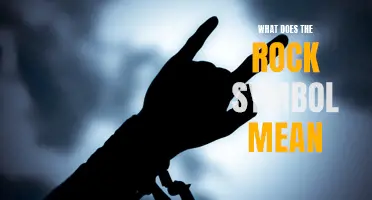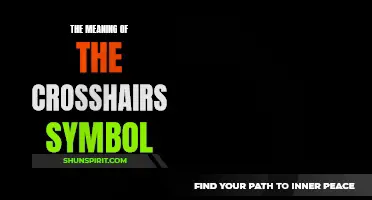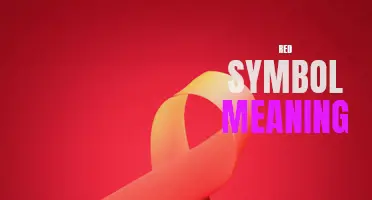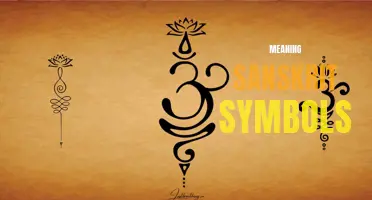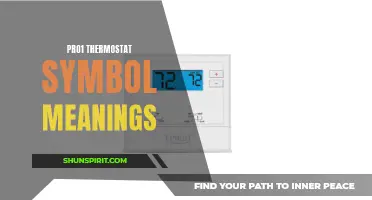
The Celtic cross is a powerful and evocative symbol that carries deep meaning and rich history. With its intricate design and intertwining patterns, the Celtic cross represents the fusion of two ancient cultures - the Celts and Christianity. This iconic symbol not only represents faith and spirituality, but also serves as a reminder of the enduring strength and resilience of the Celtic people. Join me on a journey to explore the mystical and profound meaning behind the Celtic cross symbol.
What You'll Learn
- What is the origin of the Celtic Cross symbol and what does it represent?
- How has the meaning of the Celtic Cross symbol evolved over time?
- Are there different variations of the Celtic Cross symbol and do they carry different meanings?
- What significance does the intersection of the horizontal and vertical beams have in the Celtic Cross symbol?
- How is the Celtic Cross symbol used in modern-day Celtic culture and religious practices?

What is the origin of the Celtic Cross symbol and what does it represent?
The Celtic Cross is a popular symbol that has deep roots in Celtic culture and history. It is a unique and intricate design that has come to represent a variety of meanings and beliefs. The origin of the Celtic Cross can be traced back to ancient times, but its precise beginnings are somewhat uncertain.
The Celtic Cross is a combination of a traditional Latin cross and a ring encompassing the intersection. The ring, also known as a halo or nimbus, adds an extra layer of symbolism to the cross. It represents eternity, unity, and the interconnectedness of all things.
The symbol itself predates Christianity and was originally associated with the sun. It was used by the ancient Celts as a way to honor and worship the sun god. As Christianity spread throughout Celtic lands, the symbol was adapted to fit the new religion. The cross was integrated into the design, signifying the crucifixion of Jesus Christ.
The Celtic Cross took on new meanings and interpretations as it evolved. It became a symbol of faith and spirituality, as well as a representation of Celtic identity and heritage. In Ireland, the Celtic Cross is often found in ancient monastic and burial sites, as well as on gravestones. It is believed to provide protection and serve as a connection to the spiritual realm.
The intricate knotwork found on many Celtic Crosses is also significant. The knots are known as "shield knots" and they symbolize protection, unity, and continuity. They are a visual representation of the interconnectedness of all things and the eternal nature of life.
Today, the Celtic Cross continues to be a popular symbol in Celtic and Irish culture. It is often worn as a piece of jewelry or displayed in homes as a sign of faith and heritage. The symbol has transcended its religious meaning and has become a symbol of Celtic pride and identity.
In conclusion, the Celtic Cross is a symbol with ancient origins that has come to represent various meanings and beliefs. Its origins can be traced back to the ancient Celts and their worship of the sun god. As Christianity spread, the symbol was adapted to fit the new religion and became a representation of faith and spirituality. The intricately designed knots on the cross symbolize protection, unity, and continuity. Today, the Celtic Cross continues to be a prominent symbol in Celtic and Irish culture, serving as a connection to the past and a source of pride for many.
The Intriguing Symbolism Behind the Doom Symbol
You may want to see also

How has the meaning of the Celtic Cross symbol evolved over time?
The Celtic Cross is a powerful symbol that has a rich history and has evolved in meaning over time. Initially, the Celtic Cross was a religious symbol used by early Christians in Ireland and other Celtic regions. However, its meaning has shifted and expanded over the centuries.
The Celtic Cross has its origins in ancient pagan Celtic culture. It is believed to have been used as a symbol of the sun and was associated with the Druids, who were the religious leaders of the Celts. When Ireland was converted to Christianity in the fifth century, the early Christians adopted the Celtic Cross as a way to incorporate their new faith into the existing Celtic culture.
In its early Christian context, the Celtic Cross represented the crucifixion of Christ. The circle at the center of the cross symbolized eternity and the eternal love of God. It was also believed to represent the sun, a powerful and important symbol in Celtic culture. The Celtic Cross became a prominent feature in Irish monasteries and graveyards, where it served as a marker of Christian burial sites.
Over time, the meaning of the Celtic Cross expanded to incorporate other symbolic elements. The interlacing patterns commonly found on Celtic crosses are known as Celtic knots, and they are believed to represent the interweaving of spiritual and earthly elements. These intricate designs symbolize the interconnectedness of all things and the ongoing journey of life and faith.
In addition to its religious significance, the Celtic Cross has also come to symbolize Irish heritage and resilience. During times of political and social unrest in Ireland, the Celtic Cross became a symbol of national identity and pride. It represented the endurance of the Irish people and their commitment to their heritage.
Today, the Celtic Cross is widely recognized as a symbol of faith and Irish identity. It is often used as a decorative motif in jewelry, clothing, and other cultural artifacts. Many people choose to get Celtic Cross tattoos as a way to honor their Celtic heritage or to express their Christian faith.
The meaning of the Celtic Cross may have evolved over time, but its power as a symbol remains strong. Whether used as a religious symbol, a representation of Irish identity, or a decorative motif, the Celtic Cross continues to inspire and resonate with people around the world.
Unveiling the Symbolism Behind the Bear Paw: What Does it Mean?
You may want to see also

Are there different variations of the Celtic Cross symbol and do they carry different meanings?
Celtic Cross symbol has deep roots in the ancient Celtic culture. The symbol is composed of a cross-shaped image with a circle in the middle. This symbol holds a special place in Celtic mythology and has been used for centuries in various forms and variations.
One of the most common variations of the Celtic Cross is known as the Celtic Knot Cross. This variation features intricate knotwork designs interwoven throughout the cross. The knots symbolize the eternal cycles of life and the interconnectedness of all things. The Celtic Knot Cross is often seen as a representation of spiritual and physical balance.
Another variation is the Celtic Cross with a ring or nimbus surrounding the cross. This variation is known as the Solar Cross or the Sun Wheel. The ring symbolizes the cycles of the sun and the changing seasons. It represents the eternal nature of the soul and the belief in the afterlife.
There is also a variation of the Celtic Cross known as the Cross Pattee. This variation features arms that are broader at the ends, giving it a more pronounced cross shape. The Cross Pattee is often associated with the Knights Templar and represents courage, faith, and protection.
Each variation of the Celtic Cross carries its own unique meaning and symbolism. However, all variations of the Celtic Cross are generally associated with spirituality, balance, and connection to the divine. The cross itself represents the union of the physical and spiritual worlds, while the circle in the center represents eternity and unity.
Overall, the Celtic Cross symbol and its variations hold deep spiritual and cultural significance. Whether it is the intricate knots of the Celtic Knot Cross or the broad arms of the Cross Pattee, each variation tells a story and carries a powerful message. Whether it is used for religious purposes or simply as a decorative design, the Celtic Cross continues to be a beloved and meaningful symbol.
Unveiling the Mystical Meanings of Talisman Symbols
You may want to see also

What significance does the intersection of the horizontal and vertical beams have in the Celtic Cross symbol?
The Celtic Cross is a widely recognized symbol that holds great importance in Celtic culture and history. It features a unique design that combines both Christian and pagan elements. One key aspect of the Celtic Cross is the intersection of the horizontal and vertical beams, which holds significant meaning.
The intersection of the horizontal and vertical beams in the Celtic Cross symbolizes the integration of two realms – the earthly and the divine. The horizontal beam represents the earthly plane, symbolizing the physical world and the human experience. It represents the axis of existence and the cyclical nature of life, with its four points aligning with the cardinal directions.
On the other hand, the vertical beam represents the divine realm, symbolizing the spiritual and heavenly dimensions. It signifies the connection between the heavens and the earth, bridging the gap between the mortal and immortal realms. It represents the axis mundi, the cosmic axis that connects different planes of existence.
The intersection of these two beams represents the meeting point between the earthly and the divine, where both realms converge. It signifies the union of opposites, balancing the material and spiritual aspects of life. This intersection is seen as a sacred space where the energies of both realms can flow harmoniously.
In addition to its metaphysical significance, the intersection of the horizontal and vertical beams in the Celtic Cross also holds cultural and historical importance. The cross itself is a Christian symbol, representing the crucifixion of Jesus Christ and his sacrifice for humanity. By incorporating pagan elements, such as the circle, the Celtic Cross symbolizes the integration of Celtic spirituality with Christianity.
Furthermore, the Celtic Cross has deep roots in Celtic mythology, where it is associated with the sun god Lugh and the sun wheel. The point where the vertical and horizontal beams meet is seen as the center of the wheel, representing the power and radiance of the sun. This intersection is often interpreted as a symbol of wholeness, balance, and the eternal cycle of life.
Overall, the intersection of the horizontal and vertical beams in the Celtic Cross symbolizes the integration of earthly and divine realms, the union of opposites, and the harmonious blending of different spiritual traditions. It serves as a visual reminder of the interconnectedness of all aspects of existence and the quest for balance and unity. The Celtic Cross continues to be a powerful symbol, resonating with people of various backgrounds and beliefs.
Understanding the Broken Infinity Symbol: Meaning and Significance
You may want to see also

How is the Celtic Cross symbol used in modern-day Celtic culture and religious practices?
The Celtic Cross is a symbol that holds significant meaning in Celtic culture and religious practices. It is a cross with a circular ring intersecting the lines, creating a distinctive design that has become iconic over the years. This symbol can be seen in various contexts in modern-day Celtic culture, ranging from jewelry to religious ceremonies.
One of the most common uses of the Celtic Cross symbol is in jewelry. Many people wear Celtic Cross necklaces or pendants as a way of expressing their Celtic heritage and spirituality. These pieces of jewelry are often intricately designed, with unique patterns and symbols that add to the overall beauty of the cross. Some individuals may also choose to get tattoos of the Celtic Cross to permanently showcase their connection to their Celtic roots.
In religious practices, the Celtic Cross is used as a sacred symbol in Paganism and Christianity. In Paganism, the cross represents the meeting point of the divine and the earthly realms, symbolizing the cyclical nature of life and the seasons. It is often used as an altar piece or incorporated into rituals and ceremonies.
In Christianity, the Celtic Cross is often regarded as a Christian symbol with added Celtic influence. It combines the traditional Christian cross with elements of Celtic art and culture. The ring that surrounds the cross is believed to represent eternity, emphasizing the infinite love and grace of God. Many churches and religious institutions have Celtic Crosses adorning their grounds or incorporated into stained glass windows and other artwork.
Aside from jewelry and religious practices, the Celtic Cross is also found in various cultural events and celebrations. Parades, festivals, and other Celtic gatherings often display the symbol prominently as a way of expressing Celtic pride and heritage.
Overall, the Celtic Cross is a symbol that has a strong presence in modern-day Celtic culture and religious practices. Its significant meaning and visually appealing design make it a beloved emblem of Celtic identity. Whether worn as jewelry, used in religious ceremonies, or displayed at cultural events, the Celtic Cross serves as a powerful reminder of Celtic heritage and spirituality.
The Meaning behind the St. Jude Symbol: A Beacon of Hope and Healing
You may want to see also
Frequently asked questions
The Celtic cross is a symbol that combines a cross with a circle surrounding the intersection, and it has deep cultural and religious significance in Celtic and Christian traditions. Its exact meaning can vary depending on the context and individual interpretations. However, it is commonly associated with themes of faith, spirituality, and the unity of different worlds or realms.
The origins of the Celtic cross can be traced back to the early Christian missionaries in Ireland and other Celtic lands during the 5th and 6th centuries. They combined the traditional symbol of the cross with elements of pre-Christian Celtic artwork, such as intricate knotwork, often to attract and incorporate elements of the local culture into Christian teaching.
No, the Celtic cross is not exclusively used by Christians. While it has strong Christian associations, the symbol is also used by people of Celtic heritage to symbolize their cultural identity and connection to Celtic traditions. In modern times, it is often used as a decorative motif in jewelry, tattoos, and artwork, regardless of religious affiliation.
Yes, there are several variations of the Celtic cross symbol. One popular variation is the ringless Celtic cross, which does not have a circle surrounding the intersection. Another variation is the sun cross, which incorporates a sunburst pattern behind the cross. These variations can have slightly different meanings based on the specific elements included.
In Christianity, the Celtic cross is seen as a symbol of Christ's triumph over death and eternal life. The circle surrounding the cross can symbolize God's infinite love and the unending nature of the divine. In Celtic mythology, the symbol is associated with the Celtic sun god and the balance of earthly and divine realms. Ultimately, the meaning of the Celtic cross can be deeply personal and can vary depending on an individual's beliefs and interpretations.


